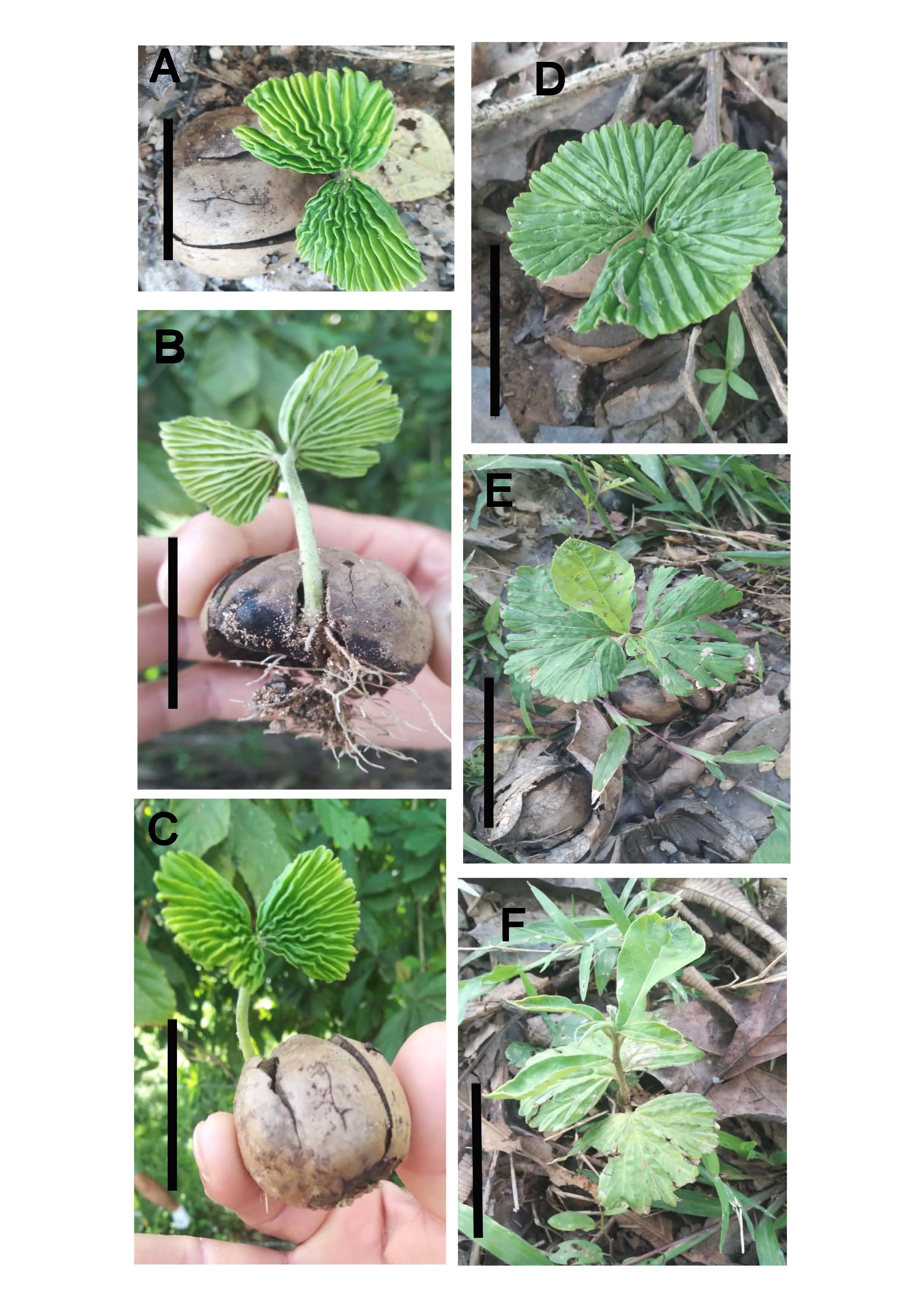Abstract
We describe here a new species of the genus Cordia, C. nicandroides, from Northern Colombia, characterized, particularly, for its large drupaceous, nuciform fruits, protected by a wide, pentasided, accrescent calyx. This tree is mainly distributed in humid forests or transition to dry forests, associated with water courses. It has notable affinities with Cordia oncocalyx, an anemochorous species, endemic to the Caatinga and Atlantic Forest biomes of eastern Brazil. However, it differs clearly from C. oncocalyx, first, for its smaller fruiting calyxes (43–45 x 53–56 mm) closely attached to the fruit, compared to C. oncocalyx larger ones (43–80 x 45–75 mm) and not attached to fruits, besides the larger, broadly ovoid fruits (40-42 x 38-40 mm) vs. the C. oncocalyx broadly ellipsoid fruits (17-21 x 16-19 mm). The species’ habitat and these larger and more compact fruits, with a rigid and parchment-like calycine envelope, suggest hydrochory syndrome in the type of diaspore dispersal.
References
Angiosperm Phylogeny Group [APG] IV. (2016). An update of the Angiosperm Phylogeny Group classification for the orders and families of flowering plants: APG IV. Botanical Journal of the Linnean Society, 181, 1-20. https://doi.org/10.1111/boj.12385
Baillon, H.E. (1891). Histoire des plantes, vol. 10. Librairie Hachette. http://dx.doi.org/10.5962/bhl.title.40796
Batianoff, G.N., Naylor, G.C., Dillewaard, H.A., Nelder, V.J. (2009). Plant strategies, dispersal and origins of flora at the northern Coral Sea Islands Territory, Australia. Cunninghamia, 11(1), 97-106.
Carvalho, P.E.R. (2008). Pau branco-do-sertao (Auxemma oncocalyx). Circular técnica, 153, 1-6.
Dauby, G., Stevart, T., Droissart, V., Cosiaux, A., Deblauwe, V., Simo-Droissart, M., Sosef, M. S.M., Lowry II, P.P., Schatz, G.E., Gereau, R.E., Couvreur, T.L.P, (2017). ConR: An R package to assist large-scale multispecies preliminary conservation assessments using distribution data. Ecology and Evolution, 7, 11292-11303.
Ellis, B., Daly, D.C., Hickey, L.J., Johnson, K.R., Mitchell, J.D., Wilf, P., Wing, S.L. (2009). Manual of leaf architecture. Cornell University Press and the New York Botanical Garden Press. https://doi.org/10.1079/9781845935849.0000
Fernández-Alonso, J.L. & Melo, J.I.M. (2021). A new species of Varronia P. Browne (Cordiaceae) from central Colombia. Phytotaxa, 507(1), 121-130. https://doi.org/10.11646/phytotaxa.507.1.8
Gentry, A.H. (2009). Bignoniaceae. Flora de Colombia Nº 25. Instituto de Ciencias Naturales, Universidad Nacional de Colombia.
Gottschling, M., Miller, J.S., Weigend, M., Hilger, H.H. (2005). Congruence of a phylogeny of Cordiaceae (Boraginales) inferred from ITS1 sequence data with morphology, ecology, and biogeography. Annals of the Missouri Botanical Garden, 92, 425-437.
Gottschling, M. & Miller, J.S. (2006). Clarification of the taxonomic position of Auxemma, Patagonula, and Saccelium (Cordiaceae, Boraginales). Systematic Botany, 31(2), 361-367.
Gottschling, M., Weigend, M., Hilger, H.H. (2016). Ehretiaceae. Pp. 165-178, en: J.W. Kaldereit & V. Bittrich (Eds.). Flowering Plants. Eudicots, The Families and Genera of Vascular Plants 14. Springer, Cham. https://doi.org/10.1007/978-3-319-28534-4_12
Guimaraes, I.P., Coelho, M.F.B., Azevedo, R.A.B. (2013). Pau branco (Cordia oncocalix Allemão) - Boraginaceae: Árvore endêmica da Caatinga. Revista Verde de Agroecologia e Desenvolvimento Sustentável, Pombal, 8, 31-39 (Edição Especial).
Harris, J.G. & Harris, M.W. (2001). Plant identification terminology: An illustrated glossary. 2nd ed. Spring Lake Publishing.
Heigl, H.M.L., Kretschmann, J., Hilger, H.H., Gottschling, M. (2020). Flower and fruit anatomy of Cordia nodosa Lam. and Varronia bonplandii Desv. (Cordiaceae, Boraginales) with phylogenetic implications. Organisms Diversity & Evolution, 20, 9-2.
IUCN Standards and Petitions Committee (2022). Guidelines for using the IUCN Red List Categories and Criteria. Version 15.1. Prepared by the Standards and Petitions Committee. https://www.iucnredlist.org/documents/RedListGuidelines.pdf
Johnston, L.M. (1951). Studies in the Boraginaceae, XX. Representatives of three subfamilies in Eastern Asia. Journal of the Arnold Arboretum, 32, 62-78.
JSTOR. (2024). Global Plants database JSTOR. https://plants.jstor.org/
Luebert, F., Cecchi, L., Frohlich, M.W., Gottschling, M., Guilliams, C.M., Hasenstab-Lehman, K.E., Hilger, H.H., Miller, J.S., Mittelbach, M., Nazaire, M., Nepi, M., Nocentini, D., Ober, D., Olmstead, R.G., Selvi, F., Simpson, M.G., Sutorý, K., Valdés, B., Walden, G.K., Weigendet, M. (2016). Familial classification of the Boraginales. Taxon, 65, 502-522.
Melo, J.I.M., Paulino, R.C., Oliveira, R.C., Vieira, D.D. (2018). Flora of Rio Grande do Norte, Brazil: Boraginales. Phytotaxa, 357(4), 235-260. https://doi.org/10.11646/phytotaxa.357.4.1
Miller, J.S. (2016). Cordiaceae, pp.1109-1113. En: Bernal, R., Gradstein, S.R. & Celis, M. (Eds.). Catálogo de Plantas y Líquenes de Colombia, Vol. 1. Universidad Nacional de Colombia.
Miller, J.S. (2023). New Boraginales from tropical America 11: New species of Cordia from Colombia, Ecuador and Peru. Novon, 31(1), 118-122. https://doi.org/10.3417/2023799
Miller, J.S. & Gottschling, M. (2007). Generic classification in Cordiaceae (Boraginales): Resurrection of the genus Varronia P. Br. Taxon, 56, 163-169.
Miller, J.S., Robinson, C, Victoria, P. (2023). A new species of Cordia (Boraginales: Cordiaceae) from Colombia and Venezuela. Novon, 31(1), 123-125. https://doi.org/10.3417/2023805
R Core Team (2017). R: A Language and Environment for Statistical Computing. https://www.Rproject.org/
Santos, J.C., Leal, I.R., Almeida-Cortez, J.S., Fernandes, G.W., Tabarelli, M. (2011). Caatinga: the scientific negligence experienced by a dry tropical forest. Tropical Conservation Science, 4(3), 276-286. www.tropicalconservationscience.org
Seculin Glur, J.L., Gutiérrez, F., Leiva, S., Barboza, G.E., Carrizo, G. (2022). Evolutionary insights into the Andean genus Nicandra (Solanoideae, Solanaceae). Phytotaxa, 572(2): 182-192. https://doi.org/10.11646/phytotaxa.572.2.5
Stearn, W.T. (1998). Botanical Latin, Cuarta edición. Davis & Charles Publishers.
Thiers, B. (2020). Index Herbariorum: A global directory of public herbaria and associated staff. New York Botanical Garden’s Virtual Herbarium. http://sweetgum.nybg.org/science/ih/
UICN. (2012). Categorías y Criterios de la Lista Roja de la UICN, versión 3.1, ed. 2. Gland, Suiza y Cambridge, Reino Unido: UICN.

This work is licensed under a Creative Commons Attribution-NonCommercial-NoDerivatives 4.0 International License.
Copyright (c) 2024 Revista de la Academia Colombiana de Ciencias Exactas, Físicas y Naturales

